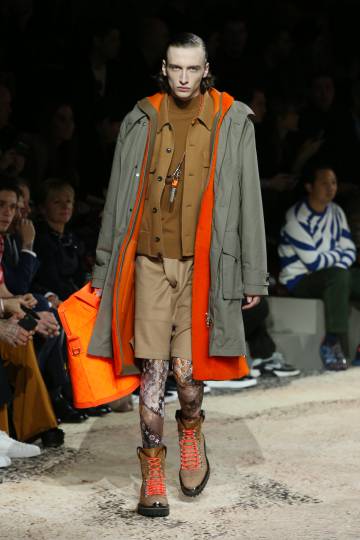Everything
From the outside, the parades of Paris Fashion Week generally seem a fantastical world populated by improbable characters who changes arbitrarily every season.
But in reality, it is a landscape of pioneering brands that will heavily influence the clothes almost all of us wear (eventually), building their identity based on standout looks that change every six months. Some looks are easy to imagine wearing. Others are outrageous but doable. Some are just plain strange and will probably not see the light of day on real folk walking the streets.
But truly great fashion design changes perceptions and pushes society in new directions. Lemaire, for example, is a small firm that makes the kind of clothes seemingly custom-made for buff footballers. Square-cut jackets and large suits in muted tones, come with an impressive variety of pants: think wide and cropped, high and very wide, or loose with an elasticated drawstring waist.
While an unconventionally sporty physique isn’t mandatory, it does help if you’re 1.85m and weigh 80kg. Just as women who want to dress well without looking beige wear head to Céline, men who wouldn’t recognise themselves in a jacket with elbow pads and skinny pants have Lemaire.

Dries Van Noten is one of the few independent brands with enough weight to compete with the big design houses for the public’s attention. Theirs is a mixture of tailoring, multicultural influences and seemingly meaningless youthful culture that sets its own rules. For the Autumn Winter 2018 season, the Belgian designer “wanted to do something transverse, I did not want to concentrate on anything concrete, that’s why there is a bit of American influence, some feminine touches.”
It sounds risky but, every season, their collections leap from the catwalk to the coat rack, just as the seventies flared suits, cowboy shirts, square-toe shoes, military grim reapers with the back embroidery with hallucinogenic motifs, and the raincoats in this show will next season. You don’t have to be a fashion critic to love them (or pull them off, English lace pants excepted). Don’t take yourself too seriously, says Van Noten. “It’s good to be surprised.”

AMI is another brand, only more accessible, that offers variety within the familiar: wide suits, tight corduroy jackets, fishing pants and fitted coats. Its overall vibe is a bourgeois student, reinterpreted for everyone according to the norms of now. On the other hand, Miyake introduces Japanese sensibility (wrinkled, comfortable and with unexpected fabrics and colors) to everyday clothing.
Kate Moss and Naomi Campbell closed the Louis Vuitton catwalk wrapped in plastic-coated trench coats; not a typical way for British designer Kim Jones to celebrate his last men’s collection for the firm but certainly a memorable one.
This overall theme of his show was hiking deluxe: there were walking hats and aerodynamic goggles, jackets in earth tones with heat-sealed seams, high-tech raincoats printed with aerial photos of Kenyan landscapes, fluorescent dot vicuña coats and new, laconic branding models (the words either Louis or Vuitton) for those who can’t live without a logo.

“They are garments that can change, that travel in the body and transform,” said Jones in the press release waiting on each show guest seat. To say his impact on menswear at Louis Vuitton has been gargantuan since arriving seven years ago is an understatement. His style – a mixture of sport, travel, luxury and remnants of a past clubber – has connected LV with a whole new generation of luxury clients.
While fashion business for men is still a fraction of the size of womenswear, thanks to names like Jones, some luxury brands have built an interesting proposal for men that doesn’t lean heavily on blatant logos. Loewe, for example, started changing the landscape three years ago and today the controlled madness of Jonathan Anderson’s collections are already classics.
For next Autumn, he reworks masculine basics (the trench coat, the shearling jacket) and includes university inspiration: a Goya backpack made of the patchwork of schoolboy jackets, bags with rugby ball stitching and a tracksuit with the logo of the house in university letters.
In total, it’s one of the most wearable high-fashion menswear collections we’ve seen in years and welcome proof there’s more to being in style than elbow patches and skinny jeans.